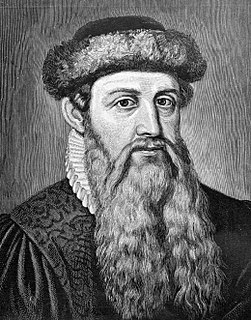
Johannes Gensfleisch zur Laden zum Gutenberg was a German inventor, printer, publisher, and goldsmith who introduced printing to Europe with his mechanical movable-type printing press. His work started the Printing Revolution in Europe and is regarded as a milestone of the second millennium, ushering in the modern period of human history. It played a key role in the development of the Renaissance, Reformation, Age of Enlightenment, and Scientific Revolution, as well as laying the material basis for the modern knowledge-based economy and the spread of learning to the masses.
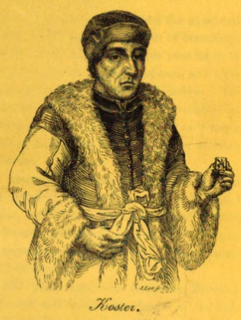
Laurens Janszoon Coster, or Laurens Jansz Koster, is the purported inventor of a printing press from Haarlem. He allegedly invented printing simultaneously with Johannes Gutenberg and was regarded by some in the Netherlands well into the 20th century as having invented printing first.

A printing press is a mechanical device for applying pressure to an inked surface resting upon a print medium, thereby transferring the ink. It marked a dramatic improvement on earlier printing methods in which the cloth, paper or other medium was brushed or rubbed repeatedly to achieve the transfer of ink, and accelerated the process. Typically used for texts, the invention and global spread of the printing press was one of the most influential events in the second millennium.

Typography is the art and technique of arranging type to make written language legible, readable and appealing when displayed. The arrangement of type involves selecting typefaces, point sizes, line lengths, line-spacing (leading), and letter-spacing (tracking), as well as adjusting the space between pairs of letters (kerning). The term typography is also applied to the style, arrangement, and appearance of the letters, numbers, and symbols created by the process. Type design is a closely related craft, sometimes considered part of typography; most typographers do not design typefaces, and some type designers do not consider themselves typographers. Typography also may be used as an ornamental and decorative device, unrelated to the communication of information.

Printing is a process for mass reproducing text and images using a master form or template. The earliest non-paper products involving printing include cylinder seals and objects such as the Cyrus Cylinder and the Cylinders of Nabonidus. The earliest known form of printing as applied to paper was woodblock printing, which appeared in China before 220 AD for cloth printing. However, it would not be applied to paper until the seventh century. Later developments in printing technology include the movable type invented by Bi Sheng around 1040 AD and the printing press invented by Johannes Gutenberg in the 15th century. The technology of printing played a key role in the development of the Renaissance and the Scientific Revolution and laid the material basis for the modern knowledge-based economy and the spread of learning to the masses.

Movable type is the system and technology of printing and typography that uses movable components to reproduce the elements of a document usually on the medium of paper.
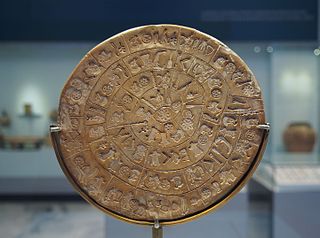
The Phaistos Disc is a disk of fired clay from the Minoan palace of Phaistos on the island of Crete, possibly dating to the middle or late Minoan Bronze Age. The disk is about 15 cm (5.9 in) in diameter and covered on both sides with a spiral of stamped symbols. Its purpose and its original place of manufacture remain disputed. It is now on display at the archaeological museum of Heraklion.

The Gutenberg Bible was the earliest major book printed using mass-produced movable metal type in Europe. It marked the start of the "Gutenberg Revolution" and the age of printed books in the West. The book is valued and revered for its high aesthetic and artistic qualities as well as its historic significance. It is an edition of the Latin Vulgate printed in the 1450s by Johannes Gutenberg in Mainz, in present-day Germany. Forty-nine copies have survived. They are thought to be among the world's most valuable books, although no complete copy has been sold since 1978. In March 1455, the future Pope Pius II wrote that he had seen pages from the Gutenberg Bible displayed in Frankfurt to promote the edition, and that either 158 or 180 copies had been printed.

Tiles are usually thin, square or rectangular coverings manufactured from hard-wearing material such as ceramic, stone, metal, baked clay, or even glass. They are generally fixed in place in an array to cover roofs, floors, walls, edges, or other objects such as tabletops. Alternatively, tile can sometimes refer to similar units made from lightweight materials such as perlite, wood, and mineral wool, typically used for wall and ceiling applications. In another sense, a tile is a construction tile or similar object, such as rectangular counters used in playing games. The word is derived from the French word tuile, which is, in turn, from the Latin word tegula, meaning a roof tile composed of fired clay.

Prüfening Abbey was a Benedictine monastery on the outskirts of Regensburg in Bavaria, Germany. Since the beginning of the 19th century it has also been known as Prüfening Castle. Notably, its extant dedicatory inscription, commemorating the founding of the abbey in 1119, was created by printing and is a unique document of medieval typography.
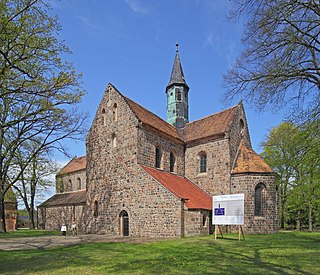
Zinna Abbey is a former Cistercian monastery, the site of which is now occupied by a village also called Kloster Zinna, today part of Jüterbog in Brandenburg, Germany, about 60 km (37 mi) south of Berlin.
Printing in East Asia originated from the Han dynasty in China, evolving from ink rubbings made on paper or cloth from texts on stone tables used during the Han. Printing is considered one of the Four Great Inventions of China that spread throughout the world. A specific type of printing called mechanical woodblock printing on paper started in China during the Tang dynasty before the 8th century CE. The use of woodblock printing spread throughout Asia, and the idea of printing perhaps spread to Europe, where German publisher and inventor Johannes Gutenberg improved on the design with the introduction of the mechanical press in the mid-15th century. As recorded in 1088 by Shen Kuo in his Dream Pool Essays, the Chinese artisan Bi Sheng invented an early form of movable type using clay and wood pieces arranged and organized for written Chinese characters. The use of metal movable type was known in Korea by the 13th century during the Goryeo period. From the 17th century to the 19th century in Japan, woodblock prints called ukiyo-e were mass-produced, which influenced European Japonisme and the Impressionists. The European-style printing press became known in East Asia by the 16th century but was not adopted. Centuries later, mechanical printing presses combining some European influences were adopted, but then replaced with newer laser printing systems designed in the 20th and 21st centuries.

The global spread of the printing press began with the invention of the printing press with movable type by Johannes Gutenberg in Mainz, Germany c. 1439. Western printing technology was adopted in all world regions by the end of the 19th century, displacing the manuscript and block printing.
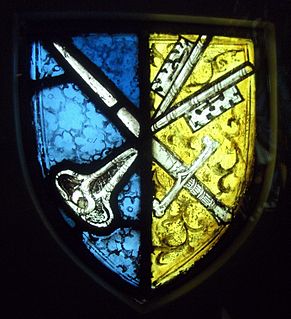
Chertsey Abbey, dedicated to St Peter, was a Benedictine monastery located at Chertsey in the English county of Surrey.

The history of printing starts as early as 3500 BCE, when the proto-Elamite and Sumerian civilizations used cylinder seals to certify documents written in clay. Other early forms include block seals, hammered coinage, pottery imprints, and cloth printing. Initially a method of printing patterns on cloth such as silk, woodblock printing for texts on paper originated in China by the 7th century during the Tang dynasty, leading to the spread of book production and woodblock printing in other parts of Asia such as Korea and Japan. The Chinese Buddhist Diamond Sutra, printed by woodblock on 11 May 868, is the earliest known printed book with a precise publishing date. Movable type was invented by Chinese artisan Bi Sheng in the 11th century during the Song dynasty, but it received limited use compared to woodblock printing. Nevertheless, the technology spread outside China, as the oldest printed book using metal movable type was the Jikji, printed in Korea in 1377 during the Goryeo era.
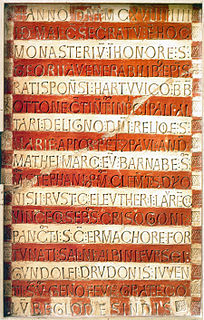
The Prüfening dedicatory inscription is a high medieval inscription impressed on clay which was created in 1119, over three hundred years before Johannes Gutenberg, by the typographic principle. The inscription plate belongs to the Prüfening Abbey, a former Benedictine monastery, in Regensburg, Germany.

A Roman lead pipe inscription is a Latin inscription on a Roman water pipe made of lead which provides brief information on its manufacturer and owner, often the reigning emperor himself as the supreme authority. The identification marks were created by full text stamps.
MS 5236 is an ancient Greek amulet of the 6th century BC, which is unique in two respects: it is the only known magic amulet of the time inscribed with a text that was stamped as opposed to incised, and it is the only extant specimen of ephesia grammata made of gold. The only partially comprehensible inscription is an invocation of the god Phoebus Apollo and may have been composed in central Greece or western Asia Minor. As such magical amulets are known to have been mass-produced, the existence of MS 5236 indicates that, despite the singularity of the foil, an inkless block printing process was practised in ancient Greece to a certain degree, for texts of some length, beyond the examples known from Roman lead pipe inscriptions and the many types of stamps used to mark bricks and pottery with the maker's name and other details.

The altarpiece of Pellegrino II is a medieval altarpiece in the cathedral of Cividale, Italy. The silver relief was endowed by Pellegrino II, the patriarch of Aquileia, around 1200 and adorns today the main altar of the church Santa Maria Assunta. It shows Mary and the Child Jesus surrounded by archangels and groups of saints. The piece is notable for its rich ornamentation and its early typographic inscription.

Aduard Abbey is a former Cistercian abbey in the village of Aduard about 8 kilometres to the north-west of Groningen in the Netherlands, founded in 1192 and dissolved in 1580.

















